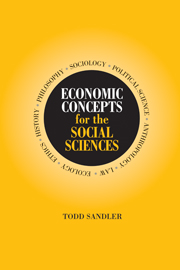Book contents
- Frontmatter
- Contents
- Table and Figures
- Preface
- 1 Economics without Apology
- 2 Back to the Future: Political Economy
- 3 In Another's Shoes: Games, Strategies, and Economics
- 4 It Takes Two or More: Public Economics and Collective Action
- 5 Government for the Politician? Public and Social Choice
- 6 Institutions Matter: The New Institutional Economics
- 7 Knowledge Is Power: Asymmetric Information
- 8 Everything Ties Together: General Equilibrium
- 9 Laboratory Economics: Of Rats and Men
- 10 Before Yesterday and Beyond Tomorrow: Intergenerational Economics
- 11 Fish, Space, and Spaceship Earth: Bioeconomics and Interdisciplinary Economics
- 12 Crystal Ball Economics: Rational Expectations
- 13 How Do We Get There from Here? Transition Economies and Policy Reforms
- 14 Economic Growth: Endogeneity, Institutions, and Other Concepts
- 15 Economic Visions of Future Horizons
- References
- Author Index
- Subject Index
13 - How Do We Get There from Here? Transition Economies and Policy Reforms
Published online by Cambridge University Press: 14 May 2010
- Frontmatter
- Contents
- Table and Figures
- Preface
- 1 Economics without Apology
- 2 Back to the Future: Political Economy
- 3 In Another's Shoes: Games, Strategies, and Economics
- 4 It Takes Two or More: Public Economics and Collective Action
- 5 Government for the Politician? Public and Social Choice
- 6 Institutions Matter: The New Institutional Economics
- 7 Knowledge Is Power: Asymmetric Information
- 8 Everything Ties Together: General Equilibrium
- 9 Laboratory Economics: Of Rats and Men
- 10 Before Yesterday and Beyond Tomorrow: Intergenerational Economics
- 11 Fish, Space, and Spaceship Earth: Bioeconomics and Interdisciplinary Economics
- 12 Crystal Ball Economics: Rational Expectations
- 13 How Do We Get There from Here? Transition Economies and Policy Reforms
- 14 Economic Growth: Endogeneity, Institutions, and Other Concepts
- 15 Economic Visions of Future Horizons
- References
- Author Index
- Subject Index
Summary
With the Velvet Revolution in Czechoslovakia, the world awoke in November 1989 to a monumental economic experiment – once never dreamed possible – involving the engineering of a transformation from a command economy to a market-based one. An entire economic system of coordination needed to be replaced by a vastly different system based on the pursuit of profits, price signals, and independent actions. A socialist economy is characterized by state ownership of enterprises, central control of production, and trade by state agreements, while a market economy is characterized by private ownership of enterprises, decentralized market coordination of production, and international trade by private agents. If Czechoslovakia had been the only economy confronting such a transition, the problem might have been less poignant, but other countries quickly rejected socialism, including East Germany, Romania, Yugoslavia, Poland, Hungary, Bulgaria, and the fifteen former Soviet republics. In 1996, there were twenty-nine transition countries attempting to transform their Soviet-based planned economic systems to a market economy. Still other communist regimes (for example, China, Cuba, and Vietnam) are currently experimenting with market reforms.
Peter Murrell (1996, p. 31) aptly describes the transition attempted from 1990 to 1996 as “the most dramatic episode of economic liberalization in economic history.” The transition involved freely fluctuating prices, trade liberalization, enterprise reform (including privatization), the creation of a social safety net, and the construction of the legal and institutional framework of a market economy.
- Type
- Chapter
- Information
- Economic Concepts for the Social Sciences , pp. 215 - 228Publisher: Cambridge University PressPrint publication year: 2001



